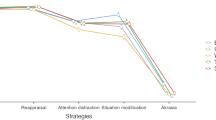Abstract
Interrelationships between factors that emerged from three self-control instruments in a sample of depressed women were examined. Empirical dimensions corresponded fairly well to dimensions described by self-control theoreticians. For example, groups of items reflecting various facets of planning and systematic problem solving clustered together regardless of the particular instrument from which they were drawn, as did item groups that reflected attention to positive information. These results also suggest several elaborations of self-control models as applied to depressed women. For example, positive thoughts and behaviors and negative thoughts and behaviors did not seem to be perceived by subjects as functionally opposite. And there was evidence of greater differentiation and complexity in subjects' perceptions of negative as compared with positive dimensions.
Similar content being viewed by others
References
Beck, A. T., Ward, C. H., Mendelson, M., Mock, J., & Erbaugh, J. (1961). An inventory for measuring depression.Archives of General Psychiatry, 4 561–571.
Cacioppo, J. T., Glass, C. R., & Merluzzi, T. V. (1979). Self-statements and self-evaluations: A cognitive-response analysis of hetersocial anxiety.Cognitive Therapy and Research, 3 249–262.
Carroll, J. D. (1976). Spatial, non-spatial, and hybrid models for scaling.Psychometrika, 41 439–463.
Corter, J. E. (1982). ADDTREE/P: A PASCAL program for fitting additive trees based on Sattath & Tversky's ADDTREE algorithm.Behavior Research Methods and Instrumentation, 14 353–354.
Halford, K., & Foddy, M. (1982). Cognitive and social skills correlates of social anxiety.British Journal of Clinical Psychology, 21 17–28.
Ingram, R. E. (1984). Toward an information-processing analysis of depression.Cognitive Therapy and Research, 8 443–478.
Johnson, S. C. (1967). Hierarchical clustering schemes.Psychometrika, 32 241–254.
Kanfer, F. H. (1971). The management of behavior by self-generated stimuli and reinforcement. In A. Jacobs & L. B. Sachs (Eds.),The psychology of private events (pp. 39–59). New York: Academic Press.
Kanfer, F. H. (1977). The many faces of self-control or behavior modification changes its focus. In R. Stuart (Ed.),Behavioral self-management. New York: Brunner-Mazel.
Kendall, P. C., Williams, L., Pechacek, T. F., Graham, L. E., Shisslak, C., & Herzof, N. (1979). Cognitive-behavioral and patient education interventions in cardiac catheterization procedures: The Palo Alto medical psychology project.Journal of Consulting and Clinical Psychology, 47 48–59.
Krantz, S. E., & Rude, S. S. (1984). Depressive attribution: Selection of different causes or assignment of dimensional meanings?Journal of Personality and Social Psychology, 47 193–203.
Kuiper, N. A., & Derry, P. A. (1981). The self as a cognitive prototype: An application to person perception and depression. In N. Cantor & J. F. Kihlstrom (Eds.),Personality, cognition, and social interaction (pp. 215–232). Hillsdale, NJ: Erlbaum.
O'Hara, M. W., Rehm, L. P., & Campbell, S. B. (1982). Predicting depressive symptomatology: Cognitive-behavioral models and postpartum depression.Journal of Abnormal Psychology, 91 457–461.
Palmon, N. (1980).The relations between self-control, the severity of the disease and the every-day functioning of epileptic patients. Unpublished master's thesis, University of Haifa.
Plutchik, R. (1980).Emotion: A psychoevolutionary synthesis. New York: Harper & Row.
Rehm, L. P. (1977). A self-control model of depression.Behavior Therapy, 8 787–804.
Rehm, L. P., Fuchs, C. Z., Roth, D. M., Kornblith, S. J., & Romano, J. M. (1979). A comparison of self-control and assertion skill treatment of depression.Behavior Therapy, 10 429–442.
Rehm, L. P., Kaslow, N. J., & Rabin, A. S. (1987). Cognitive and behavioral targets in a selfcontrol therapy program for depression,Journal of Consulting and Clinical Psychology, 55 60–67.
Rosenbaum, M. (1980). A schedule for assessing self-control behaviors: Preliminary findings.Behavior Therapy, 11 109–121.
Rosenbaum, M. (1983). Learned resourcefulness as a behavioral repertoire for the self-regulation of internal events: Issues and speculations. In C. M. Frank & Y. Jaffe (Eds.),Perspectives on behavior therapy in the eighties (pp. 54–73). New York: Springer Publishing Co.
Rosenbaum, M., & Ben-Ari, K. (1985). Learned helplessness and learned resourcefulness: Effects of noncontingent success and failure on individuals differing in self-control skills.Journal of Personality and Social Psychology, 48 198–215.
Rosenbaum, M., & Rolnick, A. (1983). Self-control behaviors and coping with seasickness.Cognitive Therapy and Research, 7 93–98.
Rude, S. S. (1986). Differential response to assertion and cognitive self-control treatments as a function of proficiency in each domain.Journal of Consulting and Clinical Psychology, 54 390–394.
Sattath, S., & Tversky, A. (1977). Additive similarity trees.Psychometrika, 42 319–345.
Simons, A. D., Lustman, P. J., Wetzel, R. D., & Murphy, G. E. (1985). Predicting response to cognitive therapy of depression: The role of learned resourcefulness.Cognitive Therapy and Research, 9 79–89.
Tversky, A., & Hutchinson, J. W. (1986). Nearest nieghbor analysis of psychological spaces.Psychological Review, 93 3–22.
Wortman, C. B., & Dintzer, L. (1978). Is an attributional analysis of the learned helplessness phenomenon viable?: A critique of the Abramson-Seligman-Teasdale reformulation.Journal of Abnormal Psychology, 87 75–90.
Author information
Authors and Affiliations
Rights and permissions
About this article
Cite this article
Rude, S.S. Dimensions of self-control in a sample of depressed women. Cogn Ther Res 13, 363–375 (1989). https://doi.org/10.1007/BF01173479
Issue Date:
DOI: https://doi.org/10.1007/BF01173479




